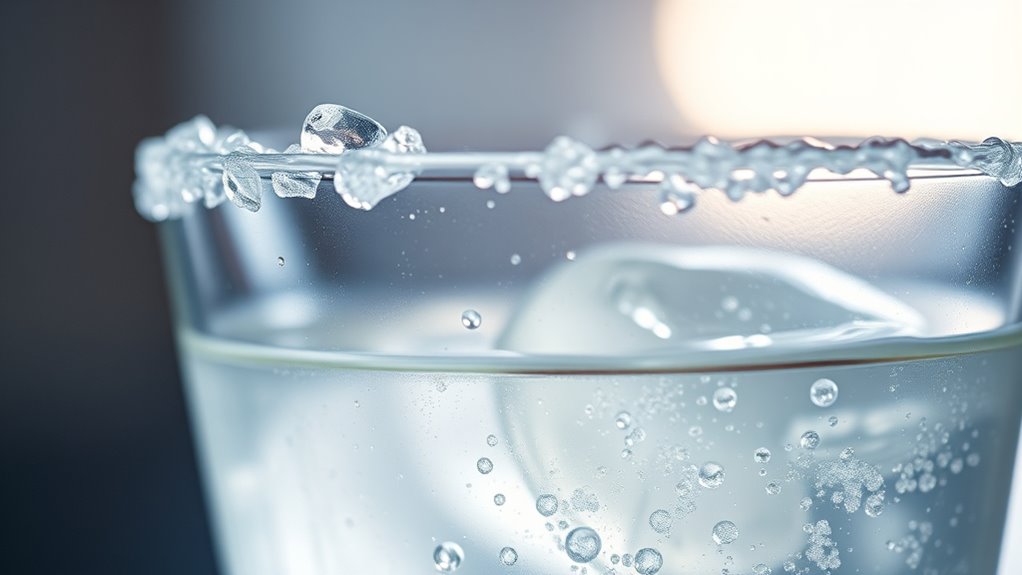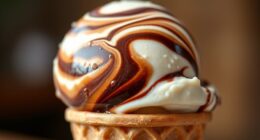When you add alcohol to frozen desserts, it lowers the freezing point, making the mixture softer and easier to scoop right from the freezer. Alcohol interferes with ice crystal formation, preventing large crystals and resulting in creamy, smooth textures. This process allows you to enjoy desserts like gelato or sorbet with a more desirable consistency. If you’re curious about how alcohol affects texture and flavor further, exploring this topic reveals even more fascinating insights.
Key Takeaways
- Alcohol lowers the freezing point of liquids, resulting in softer, more scoopable frozen desserts.
- During fermentation, alcohol disrupts water crystal formation, preventing large ice crystals.
- Even small amounts of alcohol significantly reduce the freezing temperature of mixtures.
- The lowered freezing point enhances texture, making ice creams and sorbets creamier and easier to serve.
- Chefs leverage alcohol’s properties to create unique, smooth frozen treats with complex flavors.

Have you ever wondered how alcohol affects your body and mind? When you consume alcoholic beverages, you’re engaging with a substance that has a complex impact on your physical and mental states. One interesting aspect is how alcohol influences the texture and consistency of certain foods and drinks, specifically through its effect on freezing points. Alcohol lowers the freezing point of liquids, which results in softer textures when items like ice creams or frozen desserts are made with alcohol-infused ingredients. This phenomenon occurs because alcohol molecules interfere with the formation of ice crystals, preventing them from growing large enough to make the mixture solidify completely. Instead, the result is a semi-frozen, smooth, and creamy consistency that’s more palatable and easier to scoop.
The process behind this effect starts during fermentation, where yeast or bacteria convert sugars into alcohol and other byproducts. This fermentation process not only produces alcohol but also influences the flavor profile of the final product. When alcohol is included in recipes or beverages, it acts as a natural solvent, disrupting the crystallization process of water. That’s why adding even a small amount of alcohol can considerably lower the freezing point. Consequently, ice cream or sorbet with alcohol tends to remain softer and more scoopable straight from the freezer. This is particularly useful when you want a dessert that combines the richness of cream with a touch of alcohol, such as a liqueur-infused gelato or a boozy sorbet.
Beyond texture, alcohol contributes to flavor enhancement by infusing complex notes into foods. During fermentation, various compounds develop that add depth and character to the final product. When incorporated into frozen treats or beverages, alcohol doesn’t just alter the physical state—it also amplifies taste, making each bite or sip more vibrant. The balance between alcohol content and other ingredients determines whether the dessert remains soft or becomes too runny. Chefs and home cooks often use this knowledge to create unique textures and flavor combinations, especially in gourmet desserts.
In essence, alcohol’s ability to lower the freezing point is a deliberate tool in culinary arts, used to craft softer, more enjoyable textures while simultaneously enhancing flavor. Its role extends beyond mere intoxication; it shapes the sensory experience of many frozen treats and drinks. By understanding how the fermentation process and alcohol’s properties influence freezing and flavor, you can better appreciate the science behind your favorite desserts and how they achieve that irresistibly smooth, flavorful quality. Additionally, exploring the science of freezing points can further deepen your understanding of how ingredients interact during preparation.
Frequently Asked Questions
Does Alcohol Affect the Nutritional Value of Frozen Desserts?
Alcohol does affect the nutritional value of frozen desserts, but the impact is usually minimal. It can add calories, so you should consider caloric considerations when enjoying treats with alcohol. Since alcohol doesn’t contain essential nutrients, it slightly reduces overall nutritional impact. Keep in mind, moderation is key to balancing flavor and nutrition, especially if you’re watching your intake or aiming for healthier options.
Can Alcohol Be Used to Prevent Ice Crystal Formation in All Foods?
Imagine a magic wand that keeps your favorite foods perfectly creamy—alcohol can be that magic in food preservation. While it helps prevent ice crystal formation, its alcohol compatibility varies across foods. You can’t use it universally, as some textures or flavors might clash. So, yes, alcohol can be a useful tool for preventing ice crystals, but you need to contemplate each food’s unique properties for best results.
What Types of Alcohol Are Most Effective for Lowering Freezing Points?
You should choose high-proof alcohols like vodka, rum, or bourbon, as they have the lowest freezing points, making them most effective at lowering the freezing point of foods. These alcohol types contain a higher concentration of alcohol, which disrupts ice crystal formation. When added, they help maintain a softer texture by preventing the food from freezing solid, ensuring a smoother, more desirable consistency.
Are There Safety Concerns With Using Alcohol in Homemade Frozen Treats?
You should be cautious about alcohol toxicity when making homemade frozen treats. Using too much alcohol can make your dessert unsafe to consume, especially for children or sensitive individuals. Guarantee proper measurements and avoid excessive alcohol. By prioritizing homemade safety, you prevent potential health risks. Always follow recommended guidelines to enjoy a soft, icy treat without compromising safety, and remember that moderation keeps your frozen desserts both delicious and safe.
How Does Alcohol Concentration Influence Texture and Taste in Frozen Products?
You’ll find that higher alcohol concentrations intensify the alcohol flavor, which can overpower other tastes if too strong. It also enhances texture by preventing the mixture from freezing solid, resulting in a softer, creamier consistency. However, balancing alcohol levels is key—too much can make the treat overly boozy and affect overall flavor harmony. Adjusting alcohol cautiously ensures your frozen product has the desired texture and a pleasant, subtle alcohol flavor.
Conclusion
Just as a gentle breeze pushes clouds apart, alcohol lowers the freezing point of your mixture, softening textures like a whisper of spring’s warmth. By understanding this delicate balance, you can craft desserts that melt in your mouth, inviting comfort and delight. Remember, like a painter’s subtle stroke, adding alcohol requires finesse. Embrace its power, and you’ll create treats that dance effortlessly between firmness and smoothness, transforming your culinary creations into irresistible masterpieces.










